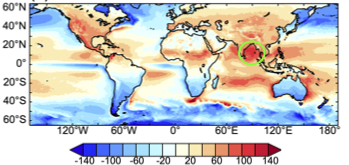An Unexpected Oceanic Energy Source for the Asian Monsoon
Land's influence on the energy supplied to the atmosphere has long been recognized as a leading cause of monsoons. However, this work shows that the global peak in net energy to the atmosphere in summer lies over the northern Indian Ocean, rather than over land as previously believed. This unexpected oceanic peak in energy input to the atmosphere occurs due to the ability of clouds over this region to trap energy in the atmosphere. Using climate model simulations, UC Berkeley researchers showed that in the absence of these radiative effects of clouds, the spatial pattern of rainfall over Asia would be vastly different, with South Asia becoming significantly drier and heavier rainfall occurring over southwestern China.
For over a century, monsoons have been understood to be caused by land-sea contrast, with a larger amount of energy transferred to the atmosphere over land than over the ocean, causing monsoon circulation. Here, researchers found that in the largest monsoon system on Earth, the energy supplied to the atmosphere is actually larger over the ocean than over land, challenging this long-standing view. Over the northern Indian Ocean, high clouds act to retain energy in the atmospheric column, while over land, clouds do not have the same impact. This key ocean-land difference in the influence of clouds on the atmosphere plays a crucial role in determining where rainfall occurs in the Asian monsoon. Clouds are widely recognized as a leading source of uncertainty in how the climate system will respond to increasing greenhouse gas concentrations; however, many studies of clouds’ role in climate have not accounted for this land-ocean difference. This study, therefore, highlights an important factor to be considered in future work on clouds’ effects on climate.
UC Berkeley researchers showed that the maximum energy input to the atmosphere in summer occurs over the northern Indian Ocean, challenging long-held views about the role of land-sea contrast in monsoon circulations. They found that clouds play an important role in the accumulation of energy over the ocean and that this effect alters the spatial distribution of rainfall over the Asian continent.

